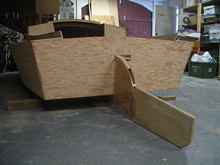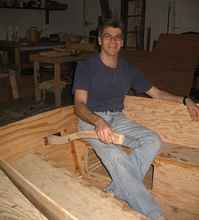| Two months ago I walked out of my
garage, midway through the construction of the rudder and cockpit
seating for my Stevenson Pocket Cruiser. I thought I would be
away for a few days while a midwinter cold snap passed through.
But three snow storms, four feet of snow, and endless days of
grey skies ransacked my plans. I huddled in my house like a refugee.
 |
Rudder and stock |
I tried to be productive. I finally tackled a long-planned bathroom
renovation and repainted the kitchen walls. But I only visited
the garage when I needed to grab a tool. I offered silent apologies
to my boat, which looked abandoned and forlorn in the cold air
and dim florescent light.
These long breaks can be dangerous for amateur boat builders.
Momentum is lost and, as attention shifts elsewhere, the sense
of urgency and excitement can dissipate. Once or twice, I looked
at my boat with detachment and wondered why I started building
it in the first place. Was it a temporary midlife madness? And
if so, what do I do now? Not for the first time, I wondered how
I could get rid of an uncompleted hull.
But as February passed, the icy path to the garage melted, temperatures
inched up a few degrees and the outside world looked less forbidding.
Skunk cabbage—a reliable precursor of spring—poked
green tips through the shallow waters of a nearby marsh and, like
other warm blooded creatures, I started stirring from my den.
My thoughts turned to the boat.
With a warm coat, gloves, and hat, I went back in the garage,
ready to pick up where I left off, but after so many weeks of
inactivity, I felt like I was staring at someone else’s
project. I found the rudder in several parts, epoxied but not
assembled. I know I had purchased the bolts needed to put it together,
but where were they now? Before the interruption, I was also preparing
to cut the cockpit seat backs—I could see some rough lines
scrawled on a sheet of plywood--but they now looked as mysterious
as ancient hieroglyphics. What, exactly, did I have in mind?
It all looked so daunting, but I forced myself to start work.
I found the missing bolts (they were still in the bag from the
hardware store) and attached the rudder blade to the stock. I
had already rough-cut the tiller, so all I needed to do was sand
it smooth, drill two holes and bolt it into the rudder. Two hours
later, the whole assembly was finished and I slid it into place
against the boat’s transom. With the addition of this simple
but unmistakably “boaty” mechanism, my wooden box
is now looking more like a real sailboat. More importantly, I
have something to do while sitting in the cockpit; I can swing
the tiller back and forth while squinting into the imaginary horizon.
 |
Tiller |
The next day, I was back out in the garage, trying to pick up
where I left off with the cockpit seating. It didn’t take
long to rediscover the purpose of my preliminary measurements
and within a few hours the plywood parts were cut and ready to
attach. I will wait for warmer days to epoxy sides in place, but
the hard work is done.
With these tasks completed, I can count on one hand the steps
needed to assemble the rest of the boat. The transom needs a motor
mount, the hatch needs a door, the cabin needs its portholes,
and the mast needs to be assembled. These are not small tasks,
but neither are they hard or intimidating. And as the “to
do” list shrinks, my sense of progress seems to accelerate.
With each hour of work, I feel measurably closer to the end. I
no longer feel that I am toiling without purpose.
Of course, one major task does loom large—fiberglassing.
Following the instructions, I plan to glass the whole exterior,
from bottom to top, but I have long dreaded this final hurdle.
Word on the street is that glassing is time-consuming, messy,
tricky and even a bit risky. I stumbled across an online post
by a builder who was giving away his partially completed craft
because he botched the glassing job and didn’t want to fix
the mistake. The story sent shivers down my spine.
But even that fear is dissipating. Just before the cold weather
hit, I decided to practice fiberglassing a few small parts. My
goal was experiment on pieces that, if necessary, could be replaced,
rather than risk catastrophe with the whole boat. I began with
the sliding hatch cover.
Following the method recommended by a very helpful online video
produced by West Systems, (link), I simply draped a piece of 3
ounce cloth over the board, then spread a thin layer of epoxy
over the surface with a flexible rubber squeegee. Like magic,
the fabric turned transparent, which let me know that it was sufficiently
impregnated. The next day, I spread another coat and, following
some light sanding, I then put down the third and final coat the
day after that. The only “mistake” was some dripping
on the edges, but the belt sander took care of that problem.
I will probably find some new challenges when I try to glass
the entire hull. But what I learned is that—like so many
other things related to boat building—a skills that seemed
hard and complex in theory was surprisingly easy in practice.
I may not do it well or efficiently, but I can do it. And for
now, that is enough.
I suspect that I am underestimating the work remaining. Even
now I am realizing that rigging will probably take some time to
figure out and the sails will cause me fits. But after such a
long delay and so many worries, I am simply pleased to be back
at work, and happy with my progress.
*********** |

